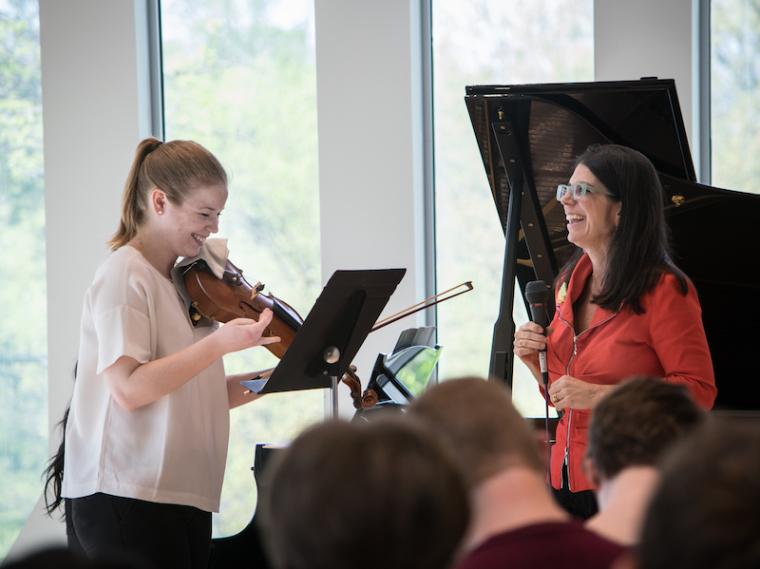Frank Talk About Injuries
June 28, 2017
Conservatory Communications Staff

After receiving acupuncture treatment for a hand injury in 2001, acclaimed violinist Pamela Frank suffered nerve damage in her arm that put her career on hold for more than a decade. She returned to the stage in 2012 but continues to enlighten young musicians on the importance of mindful playing.
Frank and physical therapist Howard Nelson presented a two-day residency in Oberlin this April that featured a master class, a workshop documenting Frank’s injury and recovery, and one-on-one sessions with students in which they were able to assess and address issues they were each facing. Frank shared the following thoughts with us during her visit.
How much did you think about health-related issues such as “movement analysis” before you sustained an injury of your own?
Not at all! In fact, I ignored many small aches over decades and never felt I had any issues.
How pervasive are the bad habits you see in young conservatory musicians today?
Most people have underlying problems that they do not think are significant or do not seek help for. Some of these may develop into full-blown injuries. Young people are more at risk because they think they are invincible. It is impossible for us to know the percentage of musicians who play with a significant pain problem, but there is no shortage of players who are seeking our help.
Are there particular factors that most commonly lead to problems among musicians with whom you have worked?
There are many factors that we see repeated that can lead to pain and injury. For example:
• Sub-optimal fit of their shoulder/chin rest combination to their anatomy. This could cause the overuse of neck muscles or the muscles on top of their shoulder to work harder in order to stabilize the instrument.
• Improper muscle use—i.e., using more muscles than are necessary for the task.
• Head stays fixed, not free.
• Postural alignment veers too far from “neutral” for too long.
• Moving the body in a way that makes it difficult to hear their sound well or that can contribute to pain.
• Not taking enough breaks when practicing or using a computer, or not performing a beneficial intervention (such as stretching) during breaks.
• Postural habits to avoid: head forward, head to the left (looking at fingers), torso rotated too far, actively pulling shoulders down, left arm pinned to the body.
Are there strategies you can share for avoiding these problems?
• Identify the movements or postures that irritate you, and minimize or eliminate them.
• Take short breaks (~30 seconds) every 20 minutes while working at a computer or practicing.
• Stretch to the opposite position from where you play.
• Don’t stand static with your instrument on your back.
• Play with the music stand as high as is comfortable at home and in rehearsal (without blocking the view of other players).
• Use a mirror and videotape to notice if you are out of neutral.
• Try to make your instrument and environment adapt to your anatomy. Modify your shoulder/chin rest as necessary.
How does one go about locating the proper specialist to help with a given problem?
Don’t be afraid to talk to everyone you know about your problem: parents, friends, teachers, mentors, colleagues, and especially to your doctor, who can lead you to an orthopedist (specialized in the body part that bothers you), a physiatrist (rehabilitation medicine), or another specialist. Physicians can prescribe physical or occupational therapy. Occupational therapists more often work with hand and wrist problems.
Through your work with students, you’re modeling attributes of today’s entrepreneurial musician: You took a challenging situation and turned it into a path of empowerment, for yourself and for others. At what point in your recovery did you realize that your own tribulations might serve as inspiration for others?
The longer and more painstaking the rehabilitation took, the more I wondered if I would ever conquer the problem. I can’t describe the gratitude I felt and still feel to be able to play again. But as with any rehab, one is never “done.” Maintenance requires mindfulness, which I will happily practice for the rest of my life.
My goal has nothing to do with entrepreneurship. If I can help destigmatize injury or help others “come out of the closet” by sharing my story, then it will have been worth the struggle. I will never take my recovery for granted and hope to forever inspire others to address their issues in an open and timely way.
Tags:
You may also like…
Oberlin Conservatory Community Mourns the Loss of Retired Professor Randolph Coleman
April 30, 2025
Coleman left a lasting legacy in the Conservatory, having created the two-year module program in composition that shaped how students learned for 20 years. He served as chair of the Composition...
Contemporary Collaborations with Third Coast Percussion
April 15, 2025
“Strum,” “Strike,” and “Bend” are all evocative references to the physicality of string and percussion instruments. And one is especially significant.
Martha Redbone Hears Her Musical Call
March 18, 2025
The vocalist and songwriter brings her distinct blend of folk, blues, gospel, and more to Finney Chapel on April 6 in an appearance with the Martha Redbone Roots Project.


